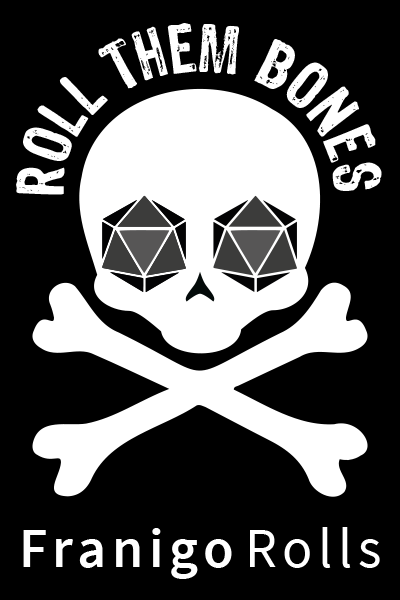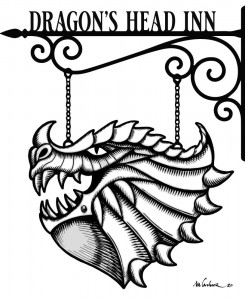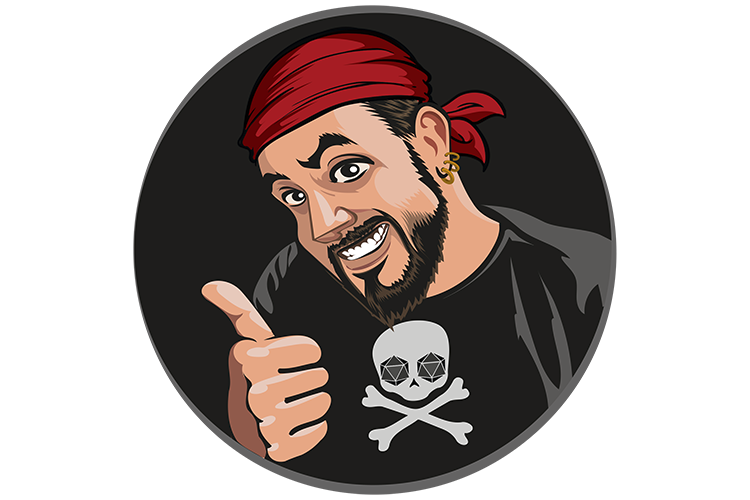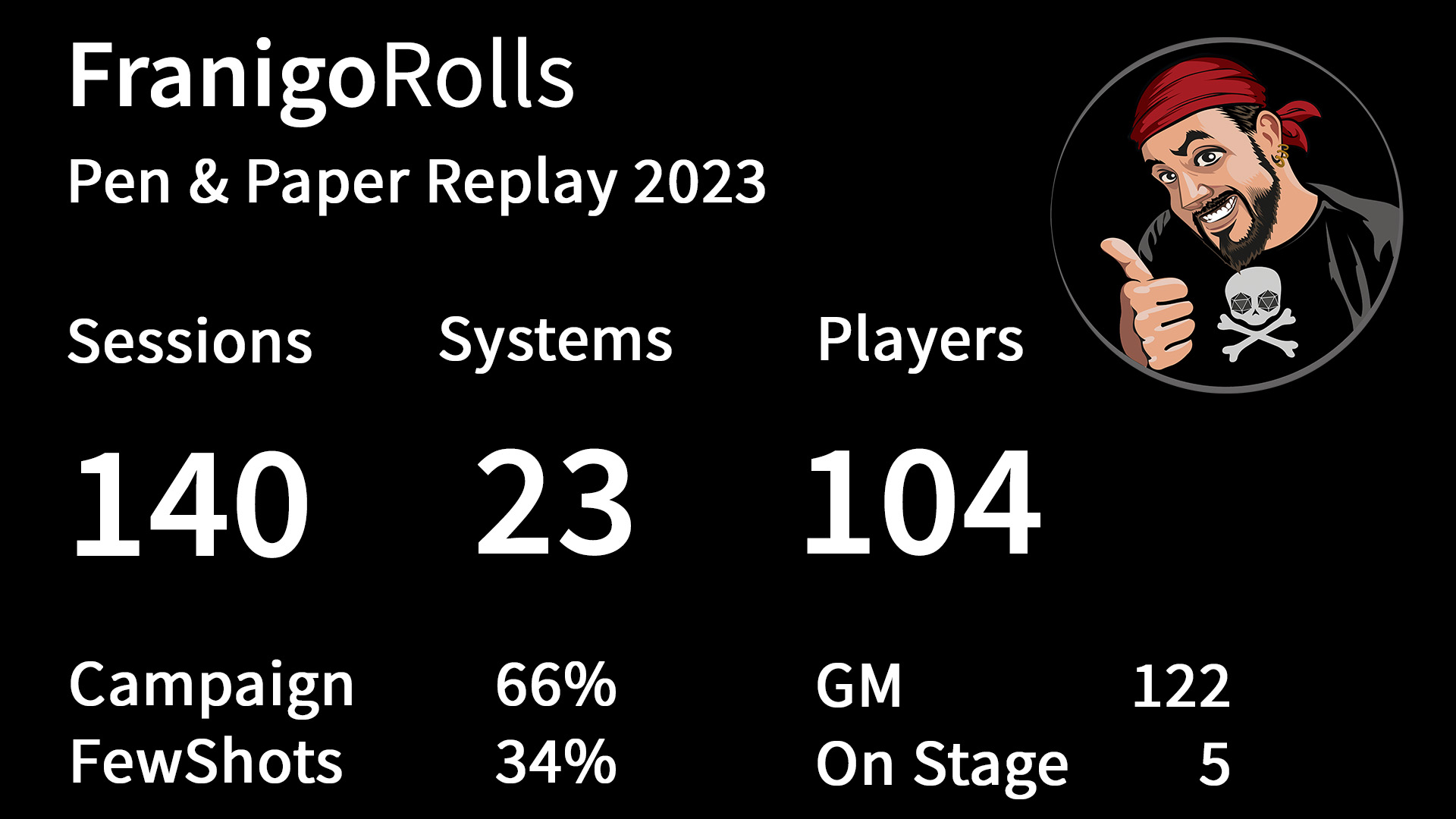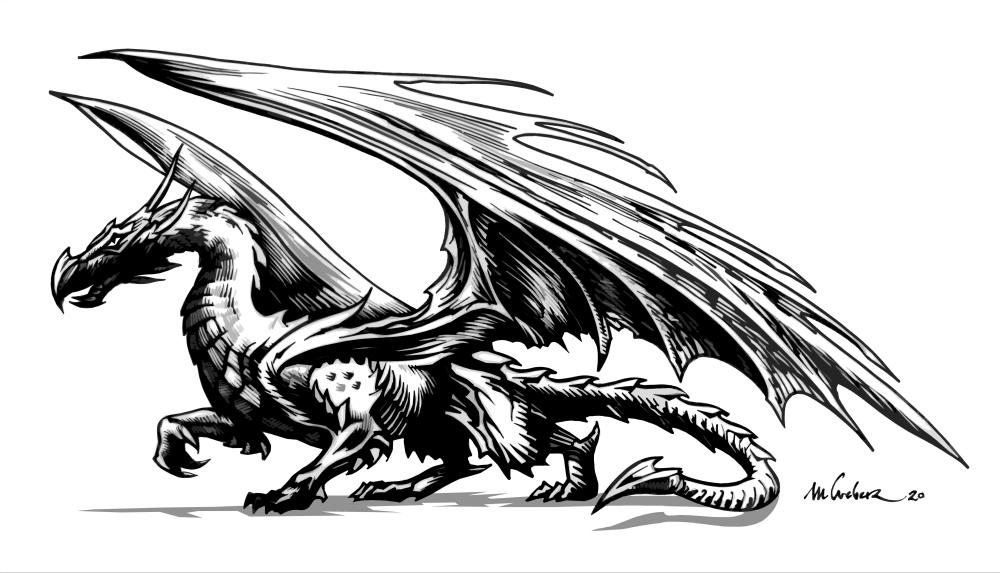
Blood in the Waters ist ein Einführungsabenteuer für die erste Edition von The One Ring, das ich als Fingerübung geschrieben habe, um mich in die Regeln einzuarbeiten. Es richtet sich dezidiert an eine neue Gruppe, die noch keine Erfahrung mit The One Ring hat, und soll der Spielleitung unter die Arme greifen. Wie das Geschwisterabenteuer Of Ghosts and Goblins wurde es im Other Minds Magazine (Ausgabe 24) veröffentlicht.
Inzwischen wurde die 2. Edition von The One Ring veröffentlicht, aber es sollte problemlos möglich sein, die Abenteuer zu konvertieren. Wer sich für The One Ring interessiert, wird auf YouTube fündig: Entweder unsere Kampagne Song of the Second Age oder das im offiziellen Setting angesiedelte Not All Who Wander.
Blood in the Waters
Preamble
Blood in the Waters is an introductory adventure for a new company. While The One Ring assumes that the player-heroes met and formed a company before the game begins, this adventure is aimed at bringing a group of player-heroes together and forming a lasting bond between them and several Loremaster characters, setting the foundation for a campaign.
A few tips for Loremasters beforehand:
- Blood in the Waters is written as a tie-in for Tales from Wilderland, especially for the mini-campaign contained in that excellent book. Events in this adventure foreshadow things to come and the driving force behind them is meant to be the main villain of Tales from Wilderland. If you do not own the book, I strongly advise you to buy it; you won’t regret it. But of course, Blood in the Waters can be played without this connection.
- The adventure is meant to showcase some of the aspects of the game, like travel, combat and encounters amongst others. The time frame is short, and it should be possible to quickly follow with the next adventure, for example The Marsh-Bell.
- In my experience, bonds not only between player-heroes, but also between them and Loremaster characters are often the driving force of a campaign and one of the main reasons that separates a long-lasting campaign from one that fizzles out. This adventure provides several Loremaster characters to that effect, from possible recurring villains to patrons, friends and contacts. Make sure to provide the players with enough hooks to these Loremaster characters.
- While the main event of Blood in the Waters is meant to be resolved by the player-heroes, a larger plot is running in the background. It is too soon for the player-heroes to find out, but you should cast a shadow nonetheless; the easiest way to do this is by having troubled Loremaster characters voice their not yet concrete concerns at the end of the adventure.
- When: The year 2946, right before the Gathering of the Five Armies.
- Where: The adventure starts in Lake-town.
- What: The company find out that Goblins have taken prisoners near Lake-town.
- Why: No-one else is near and the companions are the only hope for the captives.
- Who: The Goblins have taken Theustal and his travelling companions. They are led by Rigurz, a half-orc of great strength who is a servant of a dark power.
What happened before
Theustal, Alderman of Grenedun (which means Greenhill in the tongue of the West), a small settlement in the Grey Mountains north of the Mirkwood, set out with a young warrior named Lyskar to attend the festivities at Dale and talk to the Dwarves of Erebor. For many years, a small dwarven population had prospered in Grenedun, operating a mine, and both dwarves and humans profited from each other. But the dwarves joined their cousins at the Lonely Mountain after it was reclaimed following Smaug’s death and the Battle of Five Armies. Now Theustal wants to use the abandoned dwarven mines for his people and is determined to obtain permission to do so.
To earn good-will, he gathered gifts from his people, amongst them an old dwarven map. Unbeknown to him, the map contains the location of a dwarven keep once built to contain an old artifact of evil, and dark forces are trying to obtain it. They sent a band of Goblins, led by the Half-orc Rigurz, to capture Theustal and gain the map. The small warband attacked Theustal and his companion while they were at the Dragon’s Head Inn and took them and other people captive. Rigurz took the map and some valuables and left the Goblins to their fate, returning to the south.
Adventuring Phase
This adventure is divided into six parts:
- Part One – A journey by boat: The companions set out from Esgaroth by boat to reach Dale and take part in the celebration of the Gathering of the Five Armies. They meet each other and the other travellers, a mother and her son.
- Part Two – A grim Discovery: They arrive at the small wharf of the Dragon’s Head at the northern shore of the Long Lake, only to find the inn deserted. To their dismay, they discover signs of a fight and tracks of Goblins. As they are the only good folk in the area, the companions are asked to follow the Goblins and free their captives.
- Part Three – The taken’s only hope: The company set out and hunt the Goblins, but the sly creatures have set a trap to deter any pursuers.
- Part Four – The Battle of the Goblin Camp: Making great haste, the company discovers the Goblin camp and attack them.
- Part Five – Of Orcs and Half-orcs: The grateful captives inform the companions that two of their assailants split from the raiding party before, a Half-Orc and a great Warg. They do not know where they went.
- Epilogue – A Reception of Heroes: The company arrives at the celebrations and are welcomed by many as heroes. Gandalf the Grey asks them about the attack.
Part One – A journey by boat
The player-heroes travel by boat from Esgaroth to the Dragon’s Head Inn. The short journey takes them past the bones of the dragon and to the northern shore, where the small inn serves as a guest-house and ferry-station on the way to Dale and the Lonely Mountain. The weather is fair and everyone is in high spirits, joking and telling stories about the Battle of the Five Armies. A game of Riddle, a Song or the telling of Lore would be very appropriate.
The two young ferry-men, Adalroda and Juti, use long poles to move the flat-bottomed boat, following the coastline. The other travellers are Vetis, a mercer, and her teenage son Javri with their pony; Javri is most eager to see all the soldiers and heroes at the celebration and will treat any suitable player-hero with youthful adoration for their war-like attire and heroic outlook.
Describe the peaceful scenery, have the Loremaster characters tell jokes about Smaug and his demise. It is a warm autumn day and the future looks bright.
Part Two – A grim discovery
At the Dragon’s Head Inn
The inn sits upon the western shore of the Long Lake, near the mouth of the River Running, its wharf protected by a small cove. It consists of three buildings: a large hall where guests eat and sleep; a smaller stable for beasts of burden; and a shack that is used to keep the inn’s two pigs and a dozen chickens. There is only a low fence around the compound, just high enough to prevent chickens from running away but of no use in battle. The small wharf is used for the ferries that carry people over to the eastern shore.
The Goblin band tracked Theustal and young Lyskar since they left Grenedun, but only caught up with them on the shores of the Long Lake. They waited until nightfall and attacked the Dragon’s Head. The few people at the inn where quickly overwhelmed; only Lyskar and Otar managed to slay attackers. Both were badly wounded in return. Lyskar was taken captive, while Otar was thrown into the waters, as the Goblins believed him dead. The Goblins took all that they deemed valuable, which is about everything that they could move.
Clues
- The sign of the inn, a round shield painted with the ornate head of a dragon, is missing. It was obviously removed by force (Awareness, TN12). In fact, one of the Snaga Trackers took it and now uses it as a shield.
- There is blood on the wharf (Hunting (TN14).
- A survivor under wharf: Otar, a Barding and veteran of the Battle of the Five Armies, who slew a Goblin and was badly wounded, but managed to survive. (Search, TN14).
- A Pony named Piri managed to escape; it now grazes near the inn. (Persuade, Song or Hunting with TN14 to catch it)
- Tracks lead to the north-west (Hunting, TN14). The tracks of several Goblins and Wargs, plus the captives. A great success reveals that about half a dozen prisoners were taken by about a dozen Goblins and at least four Wargs. An extraordinary success reveals the precise numbers: 6 prisoners, 5 Wargs, 12 Orcs, two of which are larger than the rest.
Vetis offers to travel to Dale and report the attack, while Jarvi wants to pursue the Goblins, but receives a stern talking-to and sullenly follows his mother. The two ferry-men will carry Otar to Lake-town and to a healer, and promise to send help as soon as possible. The old veteran is barely conscious but he warns the company of the giant Orc with the cruel blade and his vicious Warg, not knowing that Rigurz already left the warband. All five ask the company to follow the Goblins and rescue their captives; if they do not do it, the people are lost as the Goblins will likely get away before help can arrive.
Part Three – The captives’ only hope
The Pursuit
As the player-heroes are the only ones able to help the captives, they should set out as soon as possible. The tracks lead them to the north-west. The Goblins tried to keep as much distance as possible between them and the Lonely Mountain and Mirkwood. They travelled with haste, using the Wargs as – unwilling! – beasts of burden.
Unbeknownst to the player-heroes, Rigurz ordered a small band of them to lay an ambush for any pursuers. This is as much a deterrent as a diversion; shortly thereafter, Rigurz left the main band and turned south, expertly hiding his tracks. The Goblins chose a small patch of wood for their trap. They fear Rigurz too much to disobey, but they are eager to leave and return to their ilk.
This part is about travelling the wild. All player-heroes have to roll Travel. If a Hazard episode occurs, the company runs into the ambush without notice. If no Hazard episode is triggered, the player-heroes might discover the ambush; have the lookouts roll Awareness versus the Goblin’s stealth. For this instance, assume that one of the Snaga Trackers chose the spot: roll their Survival and add their Attribute Level (2). If the player-heroes discover the ambush, they have the following options: avoid the Goblins (scouts roll Explore to circumvent the wood), try to sneak up on them (have them roll Stealth versus the Warg’s Perception) or simply attack them. If the company stumbles into the ambush, or decides to engage the Goblins in any way, Initiative and Combat Advantages are determined as per the normal rules.
Note how much time the company spends here. Lyskar is severely wounded and is in dire need of treatment. If the company loses too much time, either by avoiding the Goblins or by setting up an elaborate surprise attack of their own, the young Beorning could very well die of his wounds.
Adversaries: 2 Goblin Archers, 2 Wargs, 2 Snaga Trackers.
Part Four – The Battle of the Goblin Camp
The Goblin Camp
After Rigurz left, the Goblins lost most of their purpose. The Orc Guard took over, but since Rigurz mercilessly belittled him, he is of a dark mood. Despite the orders to move as fast as possible, he decided that the small band should settle for the day and rest, waiting for the ones they left behind. Considering himself to be a much better leader than he actually is, the Orc Guard, started to vent his anger by bullying the Goblins and sifting through the plunder, taking the best pieces for himself. Rigurz suspected this as he left, but he did not care, as the Goblins had fulfilled their purpose. The cunning Half-orc knows that pursuers are likely to catch the warband, but he figures that this will keep his foes occupied and allow him to make sure his escape.
The small warband took refuge below a massive rock that towers upon a small hill. While not a real cave, overhanging rocks grant enough shadow for the creatures to feel comfortable during the day. As long as the battle takes place there, neither the Hate Sunlight nor the Denizen of the Dark special abilities come into play. The sides of the hill are covered in bushes, allowing for a stealthy approach.
At least one Warg and one Goblin will keep watch at all times, but a surprise attack is possible with a Stealth roll. Alternatively, the captives can be freed by Stealth or by creating a diversion. If the Goblins are attacked, the Orc Guard orders one of the Snaga Trackers to kill the captives before charging into melee. The player-heroes can stop the murder with ranged attacks or by engaging the Goblin in melee. If the Orc Guard falls, all other adversaries lose 1 point of Hate.
If the player-heroes free at least some of the captives before or during the battle, two things will happen:
- Toka the serving maid discovers steel in her heart and attacks the Goblins with wild abandon with whatever weapon she is given. She pushes back and eventually slays one of them.
- Theustal defends the motionless Lyskar and the other prisoners, while Aesví throws rocks at the Goblins: each round, one adversary determined by the Loremaster is considered weary as he is peppered by rocks.
Adversaries: 2 Goblin Archers, 2 Wargs, 4 Snaga Trackers, 1 Orc Guard.
Captives: Theustal, Lyskar, Aesví, Toka, Miki & Fari.
Aftermath
If the battle is won, the freed captives are thankful and bless the player-heroes for their timely arrival. Even if Lyskar died of his wounds, no blame is laid at the player-heroes, for everyone knows they did what they could. If Lyskar is still alive, he needs immediate medical treatment; have a player-hero roll Healing. A success stabilizes the young Beorning enough to be brought to Dale on a stretcher; a great or extraordinary success brings him back to his feet.
Most of the plunder is still there, although some of it has been spoiled by the Goblins. Both pigs and all chickens have been slaughtered by the Goblins, with much of the good meat already eaten. Two dead Goblins lie nearby; they are the ones that Otar and Lyskar slew. The warband took their bodies as provisions for their journey home …
Part Five – Of Orcs and Half-orcs
Talking with the captives brings troubling news to light: the Goblins were initially led by a Half-orc named Rigurz, who was accompanied by a huge Warg. These two took some of the more valuable loot – amongst this the old map – and left shortly after the attack. To Theustal it seemed as if they did not like Goblins of the north. Rigurz spoke Westron with the Goblins, indicating that he is not of their tribe, and told them that the night of revenge would come. Nobody among the freed captives knows what this means. The significance of the map is also lost on the captives, and they rather guess that Rigurz was after more ordinary plunder, as he mostly took gold and the best provisions.
Theustal is unaware that the Goblins tracked him all the way. He knows that the Goblins hail from the Grey Mountains, though, as he could identify their dialect – he spent many a night in his youth shadowing Orcs and Goblins, and knows some of their tongue.
Epilogue – A Reception of Heroes
The company escorts the freed prisoners to the Dragon’s Head, where Aesví, Toka, Miki and Fari remain. The grateful owner hands them a reward (1 Treasure Point each) and tells them that they are always welcome at the inn.
Together with Theustal and Lyskar (if he survived) they set out towards Dale and are met by riders of King Bard, led by the young knight Arden. The riders escort them the rest of the way.
They enter the city where they are greeted as heroes and brought before the king. Several dignitaries of the Free Peoples listen to their account, amongst them King Bard, Dáin II Ironfoot, Legolas Greenleaf and Alisa, emissary of the Woodfolk. A grey robed figure keeps to himself; Gandalf is present and listens with great care, but does not involve himself in the council – yet.
Set Tolerance
While defeating the Goblins and rescuing their prisoners was an act of great valour, most of the dignitaries value Wisdom even more. As many different cultures are present, the attendants look kindly upon player-heroes from different cultures. Thus, the initial Tolerance is the highest Wisdom in the group plus one for each different culture present plus the Standing of any Barding.
Introduction
The company may use Awe or Courtesy, either telling of their heroic exploits or addressing the dignitaries with fair words. Both approaches yield the same result.
Interaction
The company may tell their tale via Courtesy, Riddle or Song. They may roll Insight on request; on a success they realize that some of the dignitaries are rather worried because of the boldness of the attack. A successful Inspire roll will rally the attendants, especially the men of the north.
Theustal only speaks when asked to, as he realizes that the tale is the company’s. If asked, he will present his view on the Goblins, and will only have the highest praise for the player-heroes.
Compare the number of successful rolls they achieved (including the Introduction) with the entries given below; higher results only supplant lower results if they improve on them.
- 0: Despite the heroic efforts of the company, the dignitaries are not impressed, and give only faint praise. They quickly fall to bickering amongst themselves as to who should do what about the Goblin threat.
- 1-2: The player-heroes are praised for their efforts and are awarded 1 Treasure Point each. Most dignitaries assume that the attack was a singular event. Still, King Bard promises to send riders to the north to hunt Goblins. Dáin II Ironfoot, King under the Mountain, decrees that Grenedun may use the abandoned dwarven mines.
- 3-4: Praise is heaped upon the player-heroes. Dáin II Ironfoot promises Grenedun aid from his miners.
- 5-6: The player-heroes are given seats of honour during the festivities. Dáin II Ironfoot sends a small band of dwarves to Grenedun to live and work there.
- 7: King Bard sends even more warriors to the north. Legolas Greenleaf promises that his people will provide guidance and provisions to any who hunt Goblins near the forest.
Regardless of the outcome of the council, Gandalf approaches the player-heroes. He seems troubled by the news and asks questions about Rigurz and his companion and about the dwarven map. It is obvious that he considers the attack significant, but he cannot yet make head or tails of it. He does not take the company into his counsel, but they have gained his attention.
Fellowship Phase
The company can now consider Grenedun and the Dragon’s Head Inn as sanctuaries. They receive 1 point of Treasure each as a reward from Theustal.
Grenedun can act as a focal point for a small series of adventures, as Theustal bids the player-heroes to visit him at any time – they could be involved in the small settlement’s struggle for survival, fighting of Goblin incursions, helping re-opening the old mine and acting as emissaries to neighbours.
Index
Persons, Beasts and Monsters
Dramatis Personae
Vetis: Lake-towner & mercer. In her mid-thirties, travel-hardened and of great experience.
Javri: Lake-towner & son of Vetis, a young lad of twelve summers. Chestnut hair, tall for his age, with bright eyes and a big grin.
Adalroda & Juti: Lake-towner & ferry-men, both in their twenties, both blond, friendly and funny.
Otar: Barding & veteran of battle, took an arrow to the knee and works at the Dragon’s Head, stalwart yet frustrated about his broken knee.
Theustal: Beorning & old man like gnarled wood. See below for a more detailed description.
Lyskar: Beorning & young warrior, tall and fair-headed, eager to prove his worth, but grievously wounded now.
Aesví: Lake-towner & owner of the Dragon’s Head, resolute woman in her forties, widowed on the night Esgaroth burned.
Toka: Bardinger & young serving maid. Seems wide-eyed and naive at first glance, but there is a hidden fire in her.
Miki & Fari: Lake-towner & servants, one old, one young, both timid and full of fear.
Notable Loremaster-characters
Rigurz
Description: Tall as a man, broad shouldered with a powerful frame, heavily scarred.
Demeanor: Rigurz has learned to constrain himself if necessary, and usually plays the part of the gruff but kind-hearted wanderer if travelling among men. When under no such obligations, he is a true sadist, inflicting pain and anguish for his own pleasure, and seeing all others only as means to his own ends
Background: Rigurz was born Rickun as the result of a terrible crime visited upon his mother by his half-orc father whom he never met. Shunned by the village of Northmen and hated by his mother, his childhood was singularly terrible. Many of his scars stem from the savage beatings he received from his mother, her long leather belt an object of terror, literally beating him to within an inch of his life. But one night, after barely thirteen winters, he stood up to his mother, took the belt and strangled her with it. He crept away that night, knowing full well what fate awaited him if the villagers found out about this crime. He searched all over the Misty Mountains for his other kin, for in his dreams the Orcs always welcomed him as one of their own. Reality proved to be a harsh mistress; the Goblins loathed him, playing cruel tricks on him, letting him scrape together a living from their refuse. For years, Rigurz survived only on anger and hate. But he grew tall and strong, and began to kill his tormentors, until he was finally driven away.
Since then, he has travelled the whole of Wilderland, at first shunned by both men and Orc. After some years of aimless wandering, he felt a call in his heart, and he followed this instinct to southern Mirkwood, where he met a new master, one who promised him vengeance on all who did him wrong. The sepulchral voice spoke of cataclysmic events, of the eradication of men, the subjugation of Orc, of wanton destruction and countless deaths, and Rigurz listened. Finally he had found a purpose.
Now he is driven by this purpose, his travels done to further the great task. He learned to walk as a man, blending in with the humans, all the while becoming a leader of Goblin and Orc through his strength and his cunning. He does not care for either, and sees others only as tools to be used and abused.
When not travelling in human disguise, he rides a powerful black Warg, a beast that is so great and terrible that there must be more than mere wolves amongst its ancestry. There is no love lost between mount and rider, but they respect each other’s strength and ferocity, and their bond is formed out of hatred for all else that lives.
Theustal
Description: Small for a man of the north, but imposing nonetheless with weathered features that show his experience and the hardships he endured. White hair and wiry arms, but he can still string and shoot a bow like a man half his age.
Demeanor: Theustal is a good listener, a man of great empathy and wisdom, who garners respect among his fellows. He is often silent while pondering situations, but when he speaks, his words carry weight.
Background: Theustal spent the first half of his life as a hunter in the wild, following the footsteps of his parents. He was based out of Grenedun, but only spent the coldest part of the winters there. He was a talented hunter of game, and also a deadly slayer of Orc and Goblin.
This all changed when he met his future wife. He settled down, remaining a hunter but roaming less and less. It was at this time that his reputation grew, for the men of Grenedun discovered him to be fair-spoken and wise. Soon, he became alderman of the small town, forging fast bonds of friendship with its neighbours, mediating in disputes and sitting as an impartial yet compassionate judge in the few trials.
He fathered several children, becoming the head of a great family. During his time as alderman, Grendeun prospered, and its people repaid his dutiful rule with loyalty. His main concern is the well-being of Grenedun, but he cares for all good folk.
Places
The Dragon’s Head Inn
Founded after the death of the dragon, the Dragon’s Head is mostly used by travellers on their way from or to Dale and the Lonely Mountain and those who travel even further east. With its two small ferries, the inn provides the most comfortable way of crossing the waters, and there are often boats to and from Lake-town.
The lodgings at the inn are simple and rough, consisting of a great hall in which travellers can make their beds, but for most the sight of the shield painted with the famous dragon’s head is still a welcome sight after traversing the wild. The food is surprisingly good, as merchants and hunters who stop by often sell or barter their goods. The prices are very affordable and Aesví, the owner, has been known to let those down on their luck stay in the stable and even giving them a hot stew without asking for money.
Grenedun
Meaning Greenhill in the tongue of the West, Grenedun is a small settlement, somewhat larger than a village but not yet a town. For centuries, the easily defended green hill was a place where Men of the North met, and so it came to pass that they erected buildings there, small cabins for travellers at first, more permanent halls after the fashion of the Men of the North later. The people of Grenedun have been a hard and sturdy folk from the beginning, living far from other humans and near the Orc-infested mountains.
So Grenedun survived for generations, a small point of light in the savage North. Its fortune changed for the better when Dwarven refugees from Erebor asked for permission to settle there. The Dwarves were welcomed with open arms and soon began to dig into the hill in search of ore. They helped build bigger halls and were instrumental in the design of the formidable defences that allowed Grenedun to survive to this day. When the Dwarves left after their ancient home was reclaimed, most in Grenedun mourned their departure.
Grenedun occupies a hilltop in the foothills below the Grey Mountains. Steep cliffs and sturdy, dwarven-built walls of stone across the only passageway protect the settlement from all aggression, and a spring ensures that there is enough fresh water to sustain any siege. Thrice the Orcs of the Grey Mountains tried to destroy Grenedun, thrice they have been defeated.
The Mines of Grenedun contain a great secret: Caves of Crystal connected to a vast cavern with an underground mere – that contains something old and evil and cunning!
Oft spielen wir in bestehenden Welten. Doch worauf gilt es da zu achten, was sind die Fallstricke, wie adaptieren wir das, was uns anspricht?
Wir strukturiert man ein Abenteuer? Wie sorgt man für einen sauberen Fluss der wichtigen Informationen? Meine Antworten auf diese Fragen!
Das Ende des Jahres ist ein guter Moment, um innezuhalten, zurückzuschauen und Bilanz zu ziehen.
